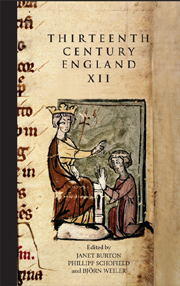Book contents
- Frontmatter
- Contents
- PREFACE
- LIST OF CONTRIBUTORS
- LIST OF ABBREVIATIONS
- The English and the Welsh in Fouke le Fitz Waryn
- Royal Piety in Thirteenth-century Scotland: The Religion and Religiosity of Alexander II (1214–49) and Alexander III (1249–86)
- The 1213 Pipe Roll and Exchequer Authority at the End of John's Reign
- The Public Debate during the Baronial Rebellion
- Richard of Cornwall and the Baronial Opposition in 1263
- Les liens personnels entre les cours de France et d'Angleterre sous le règne de Philippe III, 1270–85
- The Lay Opposition to Edward I in 1297: Its Composition and Character
- Peacekeepers and Lawbreakers in London, 1276–1321
- ‘The peace less kept’? The Origins, Revelations and Impact of Edward I's ‘Trailbaston’ Commissions of 1305–7
- Notes and Documents
- Knightly Society and the Augustinian Canons in the North-west of England
- A Year in the Life of a Royal Justice. Gilbert de Preston's Itinerary, July 1264–June 1265
- Living with Father's Reputation: The Careers of Two Thirteenth-century Oxfordshire Knights of Alien Origin, Thomas de Bréauté and Hugh de Plessis
- The Charters of Richard of Cornwall for the Empire
Knightly Society and the Augustinian Canons in the North-west of England
from Notes and Documents
Published online by Cambridge University Press: 12 September 2012
- Frontmatter
- Contents
- PREFACE
- LIST OF CONTRIBUTORS
- LIST OF ABBREVIATIONS
- The English and the Welsh in Fouke le Fitz Waryn
- Royal Piety in Thirteenth-century Scotland: The Religion and Religiosity of Alexander II (1214–49) and Alexander III (1249–86)
- The 1213 Pipe Roll and Exchequer Authority at the End of John's Reign
- The Public Debate during the Baronial Rebellion
- Richard of Cornwall and the Baronial Opposition in 1263
- Les liens personnels entre les cours de France et d'Angleterre sous le règne de Philippe III, 1270–85
- The Lay Opposition to Edward I in 1297: Its Composition and Character
- Peacekeepers and Lawbreakers in London, 1276–1321
- ‘The peace less kept’? The Origins, Revelations and Impact of Edward I's ‘Trailbaston’ Commissions of 1305–7
- Notes and Documents
- Knightly Society and the Augustinian Canons in the North-west of England
- A Year in the Life of a Royal Justice. Gilbert de Preston's Itinerary, July 1264–June 1265
- Living with Father's Reputation: The Careers of Two Thirteenth-century Oxfordshire Knights of Alien Origin, Thomas de Bréauté and Hugh de Plessis
- The Charters of Richard of Cornwall for the Empire
Summary
A portion of an early fourteenth-century stone grave cover excavated at the Augustinian priory of St Mary at Norton depicts, beneath a floriated cross, a sword with its blade covered by the arms of the Dutton family. This example of the symbolism of lineage, social class and devotional aspirations of a male member of an important family of benefactors is an especially striking one. Sometime after 1138 Robert II of Stafford, the patron of another Augustinian house, Stone Priory, confirmed the canons' possessions and granted the community substantial temporal and spiritual property. In especially warm-hearted language he requested, ‘as brother and patron of the same church of Stone’, burial with his father, and wished ‘to establish firmly for the aforesaid canons, our brothers, all the above mentioned, to hold rightly, freely and honourably quit of all exactions and secular service due to me or my heirs’. Similarly, in 1293 the canons of St Thomas near Stafford recognised their obligation to a woman they considered ‘noble and beloved’, that is, Rose of Standon, and in return for a particularly generous endowment, assented to her request for a brother to celebrate mass for the souls of herself, her heirs and the faithful departed. Clearly sentiments expressed in ways such as these should be treated with some caution. Nevertheless, they do allude to bonds between the Augustinians and their knightly benefactors that were meaningful and long-lasting.
- Type
- Chapter
- Information
- Thirteenth Century England XIIProceedings of the Gregynog Conference, 2007, pp. 141 - 154Publisher: Boydell & BrewerPrint publication year: 2009



